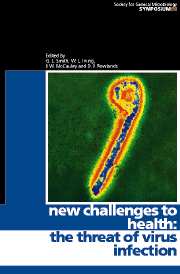Book contents
- Frontmatter
- Contents
- Contributors
- Editors' Preface
- 1 The viruses in our past, the viruses in our future
- 2 Dynamics and epidemiological impact of microparasites
- 3 The continuing threat of bunyaviruses and hantaviruses
- 4 Calicivirus, myxoma virus and the wild rabbit in Australia: a tale of three invasions
- 5 Potential of influenza A viruses to cause pandemics
- 6 The hepatitis viruses as emerging agents of infectious diseases
- 7 The emergence of human immunodeficiency viruses and AIDS
- 8 Morbilliviruses: dangers old and new
- 9 Structure–function analysis of prion protein
- 10 Endogenous retroviruses and xenotransplantation
- 11 Gammaherpesviral infections and neoplasia in immunocompromised populations
- 12 Structure and function of the proteins of Marburg and Ebola viruses
- 13 Epidemic dengue/dengue haemorrhagic fever as a public health problem in the 21st century
- 14 Borna disease virus – a threat for human mental health?
- 15 Antiviral drug development and the impact of drug resistance
- Index
2 - Dynamics and epidemiological impact of microparasites
Published online by Cambridge University Press: 06 July 2010
- Frontmatter
- Contents
- Contributors
- Editors' Preface
- 1 The viruses in our past, the viruses in our future
- 2 Dynamics and epidemiological impact of microparasites
- 3 The continuing threat of bunyaviruses and hantaviruses
- 4 Calicivirus, myxoma virus and the wild rabbit in Australia: a tale of three invasions
- 5 Potential of influenza A viruses to cause pandemics
- 6 The hepatitis viruses as emerging agents of infectious diseases
- 7 The emergence of human immunodeficiency viruses and AIDS
- 8 Morbilliviruses: dangers old and new
- 9 Structure–function analysis of prion protein
- 10 Endogenous retroviruses and xenotransplantation
- 11 Gammaherpesviral infections and neoplasia in immunocompromised populations
- 12 Structure and function of the proteins of Marburg and Ebola viruses
- 13 Epidemic dengue/dengue haemorrhagic fever as a public health problem in the 21st century
- 14 Borna disease virus – a threat for human mental health?
- 15 Antiviral drug development and the impact of drug resistance
- Index
Summary
INTRODUCTION
The current and historical impact of infectious disease on human, animal and plant populations is immense. In addition, the relationship between host and pathogen has provided fertile ground for fundamental progress in population dynamics and evolutionary biology (Anderson & May, 1991). The impact of pathogens on host populations begs important questions on both population dynamic and evolutionary timescales.
The ultimate evolutionary questions here – notably, the coevolutionary trajectory of pathogen transmissibility and virulence – depend in turn on the nonlinear population dynamic interaction between host and pathogen (Van Baalen & Sabelis, 1995). In this chapter, we focus mainly on the population dynamic timescale – discussing the pattern of pathogen impact on human host populations arising from different pathogen life histories. The chapter focuses on microparasites, especially viruses and bacteria.
The impact of pathogens is a two-edged sword – pathogen population dynamics depends at least as much on the demographic and other characteristics of the host population as vice versa. To explore these issues, we therefore need a system where both host and pathogen dynamics are extremely well understood empirically and the natural history of infection and immunity is sufficiently straightforward to permit modelling.
The paradigm of these characteristics is provided by the great childhood viral and bacterial infections, notably measles. The population dynamics and natural history of measles are particularly well studied (Anderson & May, 1991; Black, 1984; Bolker & Grenfell, 1995; Cliff et al., 1993; Grenfell & Harwood, 1997). Essentially, infection occurs in epidemics, which extinguish themselves as waves of infection immunize susceptible individuals. Epidemics tend to be episodic in small communities, though measles can be endemic in urban centres above a Critical Community Size (CCS) of 300–500 000 (Bartlett, 1960a).
- Type
- Chapter
- Information
- New Challenges to HealthThe Threat of Virus Infection, pp. 33 - 52Publisher: Cambridge University PressPrint publication year: 2001
- 8
- Cited by



